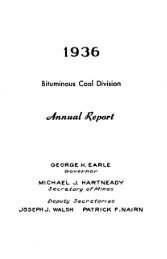Reports of the Inspectors of Mines of the anthracite coal regions of ...
Reports of the Inspectors of Mines of the anthracite coal regions of ...
Reports of the Inspectors of Mines of the anthracite coal regions of ...
You also want an ePaper? Increase the reach of your titles
YUMPU automatically turns print PDFs into web optimized ePapers that Google loves.
Ex. Doc] <strong>Reports</strong> <strong>of</strong> <strong>the</strong> <strong>Inspectors</strong> <strong>of</strong> <strong>Mines</strong>. 193<br />
Mr. Becr<strong>of</strong>t, sworn, stated as follows :<br />
Have been connected with <strong>coal</strong> mines and mining for twenty-four years ;<br />
was general inside foreman at Stockton about three years, under superin-<br />
tendent William Carr ; never witnessed a greater caving in than <strong>the</strong> one<br />
at Harleigh ; after personal observations, I was convinced that <strong>the</strong> men<br />
could not be rescued ; I believe that all possible attempts to rescue <strong>the</strong><br />
men have been made ; all <strong>the</strong> men were willing to help to get <strong>the</strong>m out<br />
was <strong>the</strong>re <strong>the</strong> evening <strong>of</strong> <strong>the</strong> accident.<br />
Mr. Llo3'd was again called on and stated that " he was satisfied that <strong>the</strong><br />
men could not be gotten out ; Mr. Becr<strong>of</strong>t, at my request, accompanied<br />
me into <strong>the</strong> mines for <strong>the</strong> purpose <strong>of</strong> rescuing <strong>the</strong> men ; went seven differ-<br />
ent ways, but could do nothing ;<br />
ble, but were forced to desist."<br />
tried every way and everything imagina-<br />
Explanations <strong>of</strong> Cross Section.<br />
The intention <strong>of</strong> presenting this section is to demonstrate <strong>the</strong> positions<br />
<strong>of</strong> <strong>the</strong> gangway's in <strong>the</strong> Harleigh collier}^, and that portion worked over <strong>the</strong><br />
boundary line. Gangway- F, on cross section, was driven from Harleigh<br />
No. 1 and No. 8 sunk under or ra<strong>the</strong>r over it to work <strong>the</strong> <strong>coal</strong> at a point<br />
lower in <strong>the</strong> "basin," as <strong>the</strong> same dipped very rapidly eastward, meets on<br />
a level with <strong>the</strong> first lift west gangway worked from Ebervale slope. No. 2.<br />
At this point a very substantial dam was built previous to <strong>the</strong> caving in<br />
<strong>of</strong> <strong>the</strong> Harleigh mine, for <strong>the</strong> purpose <strong>of</strong> damming back <strong>the</strong> water from run-<br />
ning into <strong>the</strong> Ebervale collieries, preparatory to <strong>the</strong> abandonment <strong>of</strong> <strong>the</strong><br />
Harleigh workings, as <strong>the</strong> <strong>coal</strong> had been nearl}^ worked out.<br />
This dam cost about $4,000, and contained 48,000 feet <strong>of</strong> white pine<br />
lumber, each stick <strong>of</strong> lumber was 12 feet long, 12"X12" diameter at one<br />
end, and 10" X 1 2" at <strong>the</strong> o<strong>the</strong>r. The dimensions <strong>of</strong> <strong>the</strong> dam cut out <strong>of</strong> <strong>the</strong><br />
solid <strong>coal</strong> by pick work, was 12 feet long, 23.6 feet wide at <strong>the</strong> ouside, and<br />
28.2 feet on <strong>the</strong> inside, equivalent to 2 feet <strong>of</strong> a hitch on <strong>the</strong> outside,<br />
and 6 feet on <strong>the</strong> inside, so that <strong>the</strong> greater would be <strong>the</strong> pressure, <strong>the</strong><br />
tighter <strong>the</strong> dam would get, acting in <strong>the</strong> form <strong>of</strong> a wedge. At intervals one<br />
<strong>of</strong> <strong>the</strong> sticks was left out, to serve as a key in closing <strong>the</strong> dam, and driven<br />
in with a ram, and afterwards caulked with oakum, and wedges driven in<br />
<strong>the</strong> end <strong>of</strong> <strong>the</strong> sticks on <strong>the</strong> inside <strong>of</strong> <strong>the</strong> dam, making it perfectly water-<br />
tight. Sometime after <strong>the</strong> completion <strong>of</strong> this dam, preparations were being<br />
made to build ano<strong>the</strong>r in gangway A, on section, when <strong>the</strong> Harleigh mines<br />
caved in, necessitating <strong>the</strong> abandoning <strong>of</strong> building <strong>the</strong> second, as both<br />
were futile, owing to <strong>the</strong> barrier pillar being considered too weak to resist<br />
three hundred and twenty feet head <strong>of</strong> water. The pressure on <strong>the</strong> dams<br />
was calculated to be about sixty-five to seventy pounds per square inch.<br />
The plan <strong>of</strong> <strong>the</strong> dam was gotten up by Thomas S. McNair, Esquire, civil<br />
and mining engineer, and put in by Mr. Samuel H. Bateman, both <strong>of</strong><br />
Hazleton, Pa.<br />
13_MiNE Rep.




![1945 Anthracite Annual Report Districts 19 - 25 [Adobe pdf - 9148Kb]](https://img.yumpu.com/50308099/1/190x119/1945-anthracite-annual-report-districts-19-25-adobe-pdf-9148kb.jpg?quality=85)


![1937 Anthracite Annual Report Districts 1 - 11 [Adobe pdf - 9394Kb]](https://img.yumpu.com/43539962/1/190x119/1937-anthracite-annual-report-districts-1-11-adobe-pdf-9394kb.jpg?quality=85)







![1931 Anthracite Annual Report Districts 1 - 11 [Adobe pdf - 8007Kb]](https://img.yumpu.com/39427789/1/190x119/1931-anthracite-annual-report-districts-1-11-adobe-pdf-8007kb.jpg?quality=85)

